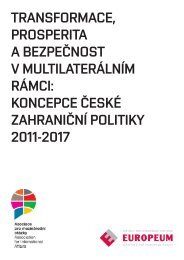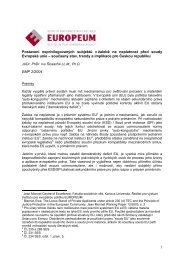eu constitutionalisation - EUROPEUM Institute for European Policy
eu constitutionalisation - EUROPEUM Institute for European Policy
eu constitutionalisation - EUROPEUM Institute for European Policy
You also want an ePaper? Increase the reach of your titles
YUMPU automatically turns print PDFs into web optimized ePapers that Google loves.
Chapter 5: The <strong>European</strong> Constitution and the Re<strong>for</strong>m of External CompetencesII. PRINCIPLES AND OBJECTIVES OF THEUNION’S EXTERNAL ACTIONIn accordance with the general structure of the CT, Part I contains theconstitutional foundations <strong>for</strong> the Union’s external competences. Severalamendments included in this Part have a direct impact on the Union’sexternal competences, its underlying procedures and implementation.A pivotal point regarding the Union’s future external relations is certainlythe proposal to introduce a single legal personality, which assumes therights and obligations of the <strong>European</strong> Community and the Union (Art. I-7CT). It comes together with the merging of the pillars, the consolidationof the EC- and EU-Treaties and the consequential embedding of the CFSPin one single legal framework. In line with the organisational restructuring,the ambition to provide <strong>for</strong> better coherence has also extended to theinstitutional side, specifically regarding the Union’s external representationand a largely uni<strong>for</strong>m procedure <strong>for</strong> the conclusion and negotiation ofinternational agreements. At the same time, the <strong>for</strong>mulation of commonprinciples and objectives <strong>for</strong> the Union’s external action would have addeda new tone to the Union’s external relations.As Article IV-438 CT stipulates, the Union will succeed to all rights andobligations of the <strong>European</strong> Community and the <strong>European</strong> Union,whether internal or resulting from international agreements. This shouldclarify the Union’s current ambiguous position in its representation tothe outside world, where legal personality is only explicitly awardedto the <strong>European</strong> Community and not to the <strong>European</strong> Union, despiteits competences, inter alia, to conclude international agreements underArticle 24 TEU. Whilst a single legal personality undoubtedly simplifiesthe current situation by providing a uni<strong>for</strong>m appearance <strong>for</strong> the Union,it raises at the same time a number of questions, specifically with regardto the conclusion of international agreements in the field of CFSP underthe new regime.Also, the joint definition of general principles and objectives <strong>for</strong> all fieldsof EU external action reflects the Convention’s intention to enhance clarityand transparency to the public and the EU’s partners. In order to ensureconsistency in EU external and internal action, the consideration of these148Chapter 5: The <strong>European</strong> Constitution and the Re<strong>for</strong>m of External Competencesprinciples and objectives would generally extend to all external aspects ofEU internal policies. It finds its first expression in the CT in an amendmentto the Union’s objectives, stipulating that the Union “in its relations withthe wider world, […] shall uphold and promote its values and interests. It shallcontribute to peace, security, the sustainable development of the Earth, solidarityand mutual respect among peoples, free and fair trade, eradication of poverty andthe protection of human rights, in particular the rights of the child, as well as to thestrict observance and the development of international law, including respect <strong>for</strong> theprinciples of the United Nations Charter.” (Art. I-3 para 4 CT).The <strong>for</strong>mulation of these objectives that should inspire the Union’s actionon the international scene clearly follows the mandate of the LaekenDeclaration to set globalisation within a moral framework. These principles andvalues are reiterated in more detail in the general provisions of Title V onthe Union’s External Action. Article III-292 CT <strong>for</strong>mulates a common setof objectives <strong>for</strong> the entire field of external relations. Instead of differentobjectives <strong>for</strong> the various fields of external action, such as the CFSP, theCCP, development cooperation, etc., the principles and objectives <strong>for</strong>mulatedin Article III-292 CT would generally apply in the developmentand implementation of the different areas of the Union’s external action,as well as the external aspects of its other policies. As Cremona observes,this would require a delicate balancing of possibly conflicting objectivesand interests, if <strong>for</strong> example the CCP would, next to its objective of abolishingrestrictions in international trade, also have an explicit sustainabledevelopment and human rights mandate.¹⁰III. THE INSTITUTIONS IN THE FRAMEWORKOF EXTERNAL RELATIONSIII.1. The Union Minister <strong>for</strong> Foreign AffairsThe ambition to enhance coherence and efficiency has also extended to theinstitutional side. The most prominent proposal in the CT is to reconsiderthe roles of the High Representative <strong>for</strong> CFSP and the Commissioner10) CREMONA (2003), p. 1349.149








